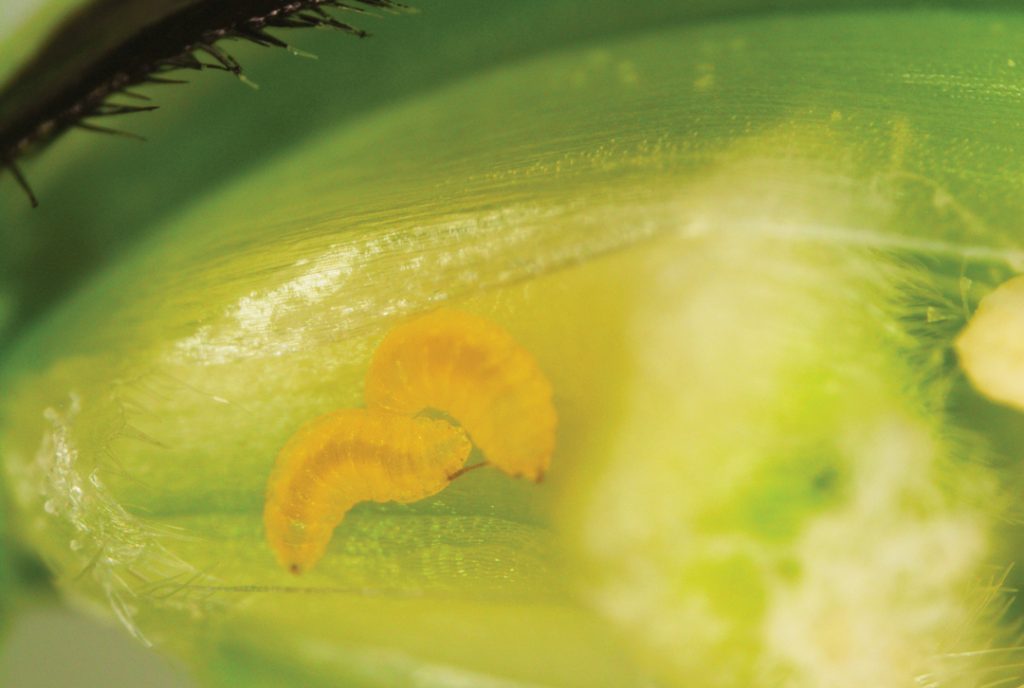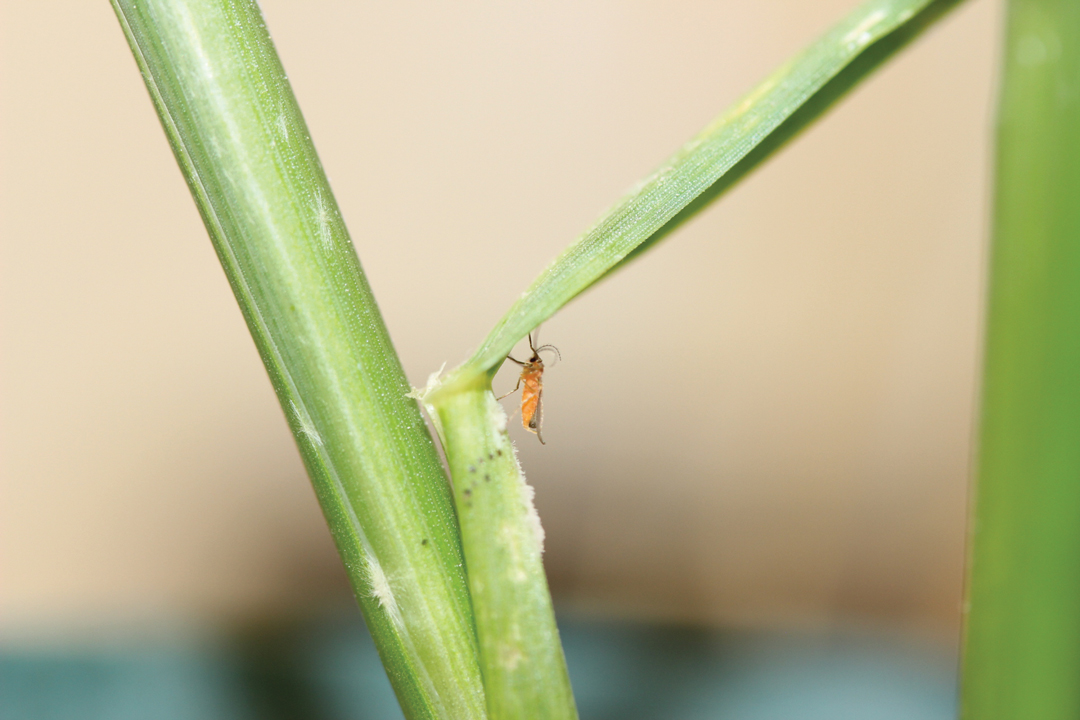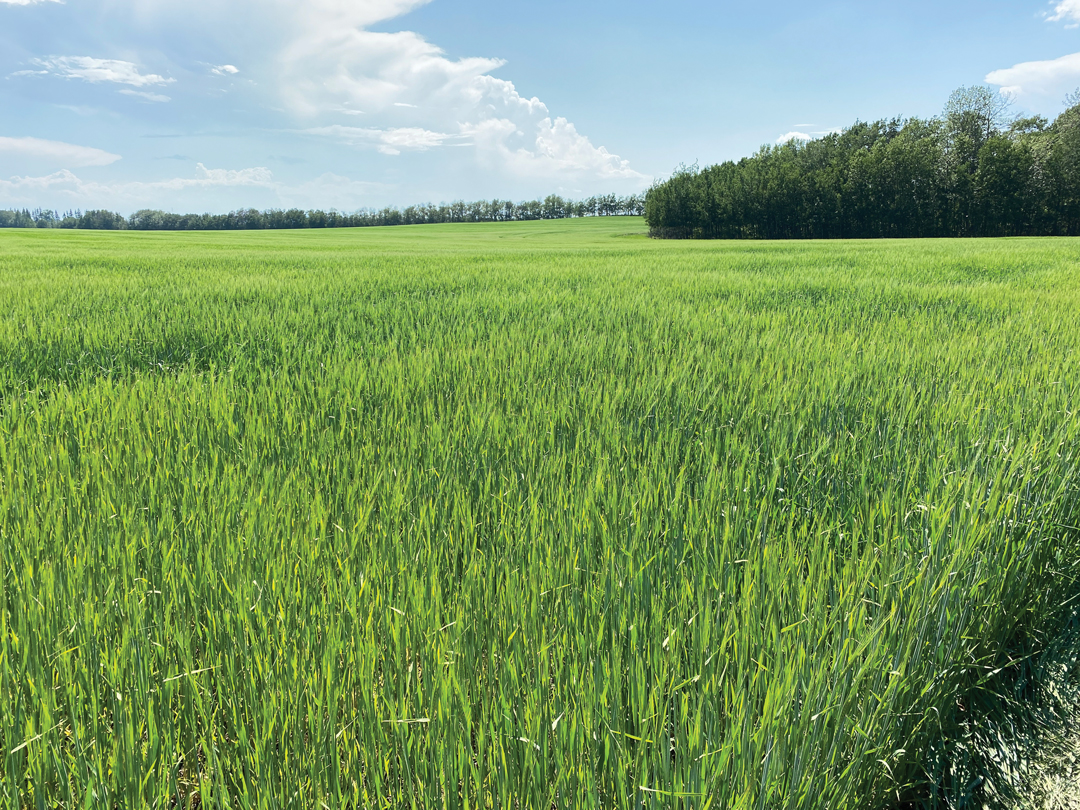MIDGE MITIGATION
BY CULLEN BIRD • PHOTOS COURTESY OF TYLER WIST, AGRICULTURE AND AGRI-FOOD CANADA
It’s one of the biggest pest threats to Alberta’s wheat farmers, but so small it’s hard to spot. Scarier still, if current control measures fail, there’s no Plan B to stop it.
The orange blossom wheat midge is a delicate, bright-orange fly. It’s half the size of a mosquito. Yet these little flies have been known to cause yield loss of more than 50 per cent in Alberta’s wheat fields.
Recent dry weather has further reduced already low populations of wheat midge, which prefer to hatch in wetter conditions. “We’ve had massive outbreaks in southwestern Alberta and the central Peace in the past, but both of those outbreaks seem to have subsided and they’re at fairly low numbers,” said Scott Meers, an insect management specialist with Alberta Agriculture and Forestry.
Wheat midge strike just when the wheat heads typically emerge in late June to early July. The eggs they lay on the wheat heads hatch into hungry larvae, which feast on the kernels. Their feeding damages, reduces or consumes the wheat kernels. None of this changes the outer appearance of the wheat head but causes loss of grade and yield.
Midge populations can “blow up” very quickly if given the right conditions, such as a couple of wet years, Meers added. “This year in central Alberta is kind of a perfect year for wheat midge so I expect to see a resurgence,” he said.
To keep an eye on wheat midge populations, Meers and his team take 300 soil samples across Alberta’s wheat regions every fall. Counting midge cocoons in the soil allows his team to gain an idea of the midge population in the area. The current low levels of wheat midge are due to an effective—but potentially vulnerable—management system built around midge-
resistant strains of wheat.
THE MIRACLE GENE
Alberta’s main line of defence against wheat midge is a group of midge-resistant wheat varieties carrying the Sm1 gene. Wheat containing Sm1 reacts to wheat midge larvae attack by increasing natural acids in the kernels that cause the larvae to stop feeding. Acid levels return to normal before the kernels mature. So far, it is the only known gene to truly deter wheat midge.
“The most effective way to deal with wheat midge if you’re in a wheat midge area is growing the resistant varieties,” said Bill Chapman, a crop extension specialist with Alberta Agriculture and Forestry.
The Sm1 gene varieties became commercially available in 2010 and are a linchpin of the wheat midge control strategy. The last severe outbreak was in 2013 in the Peace region, when wheat farms in several counties were severely damaged by midge infestations. The yield losses were somewhere in the 50 per cent range, said Meers. His team made a point of visiting farmers in the Peace region after the 2013 outbreak and advised them on how to deal with the pest, which the area’s farmers took to heart.
“In the Peace, when we had that big outbreak many producers went to that midge-tolerant wheat and the results have been spectacular,” he said. “Their losses just went away.”
VIRULENT MIDGE
Yet this weapon against wheat midge could easily be lost if farmers don’t follow industry rules on using the Sm1 system, warned Chapman. Part of the fear is that if farmers use 100 per cent midge-resistant wheat it would eliminate all wheat midge except those with a resistance to the Sm1 gene. These surviving “virulent midge” would then be able to eat Sm1 wheat.
To prevent this, scientists from Agriculture and Agri-Food Canada (AAFC) decided to use a “refuge” system in which midge-resistant seed is mixed with non-resistant wheat. About 90 per cent of the seeds are of the midge-resistant variety, while 10 per cent are non-resistant. Allowing the wheat midge to eat some of the non-resistant wheat ensures the wheat midge population remains susceptible to Sm1.
“There is going to be some small amounts of wheat midge that are out there damaging the non-resistant variety, but that’s the only way we can maintain the Sm1 gene,” said Chapman.
Farmers must buy the seed from a certified grower and sign a contract to do so. It’s best for farmers to avoid growing their own midge-resistant seed, since it’s difficult to mix the two wheat varieties together, according to Chapman. “If we want to maintain the system, we have to follow the rules,” he said.
PEST CONTROL
Macroglenes penetrans is a parasitic wasp active in Alberta that can make a big dent in midge populations. Unfortunately, the tiny wasp doesn’t instantly kill the midge, so its benefits are generally only felt the following year.
Spraying for wheat midge requires correct timing application with the insect’s emergence. The most effective and commonly used chemical for the job is chlorpyrifos, commonly known as Lorsban, as it kills both adult midges and their eggs.
However, Canada’s Pest Management Regulatory Agency published a re-evaluation of the pesticide in May. The report recommended banning it except for a few small-scale uses. Banning chlorpyrifos would create a bad situation, said Meers. “In certain uses, there is nothing to replace it,” he said. The other alternative is dimethylate, which is less effective as it only kills the adult midges, not the eggs.

The insect’s larvae can cause substantial crop damage.
PLANNING FOR THE FUTURE
Currently, there is no Plan B if the Sm1 gene fails or wheat midge populations become resistant. However, there are potential control measures being studied, said Tyler Wist, a field crop entomologist with the AAFC Saskatoon Research and Development Centre.
One is an egg-laying deterrent being studied by a multi-organization partnership mostly conducted at the University of Manitoba. Launched in 2018 and concluding in 2023, the study is examining the effect of airborne chemicals produced by wheat—essentially odours—that deter wheat midge from laying eggs.
If the researchers can determine the key components of an effective odour, it could be bred into Sm1 wheat as an additional deterrent, added Wist. “So, you’ve got less egg laying and then if the eggs do get laid the Sm1 gene kicks in and takes care of them,” he said.
Wist is involved with a study researching two potential countermeasures. The first is a wheat variety that has especially hairy glumes. These may form a “mechanical deterrent” that would hopefully discourage wheat midge from landing on the wheat heads, he said.
The second is one he calls egg antibiosis. One breeder line of non-commercially available winter wheat exhibits this trait. “The eggs of the wheat midge just don’t even hatch,” he said. A quick and deadly response to egg-laying is not unheard of in other plants, said Wist. The plant recognizes eggs have been laid and quickly creates a chemical response that kills the eggs. The study began in April of this year and will continue for three years.
In the meantime, Meers said his team will continue carrying out surveys and keeping farmers informed of the wheat midge threat. “The industry really wants us to be doing this, and that’s our plan,” he said.







Comments